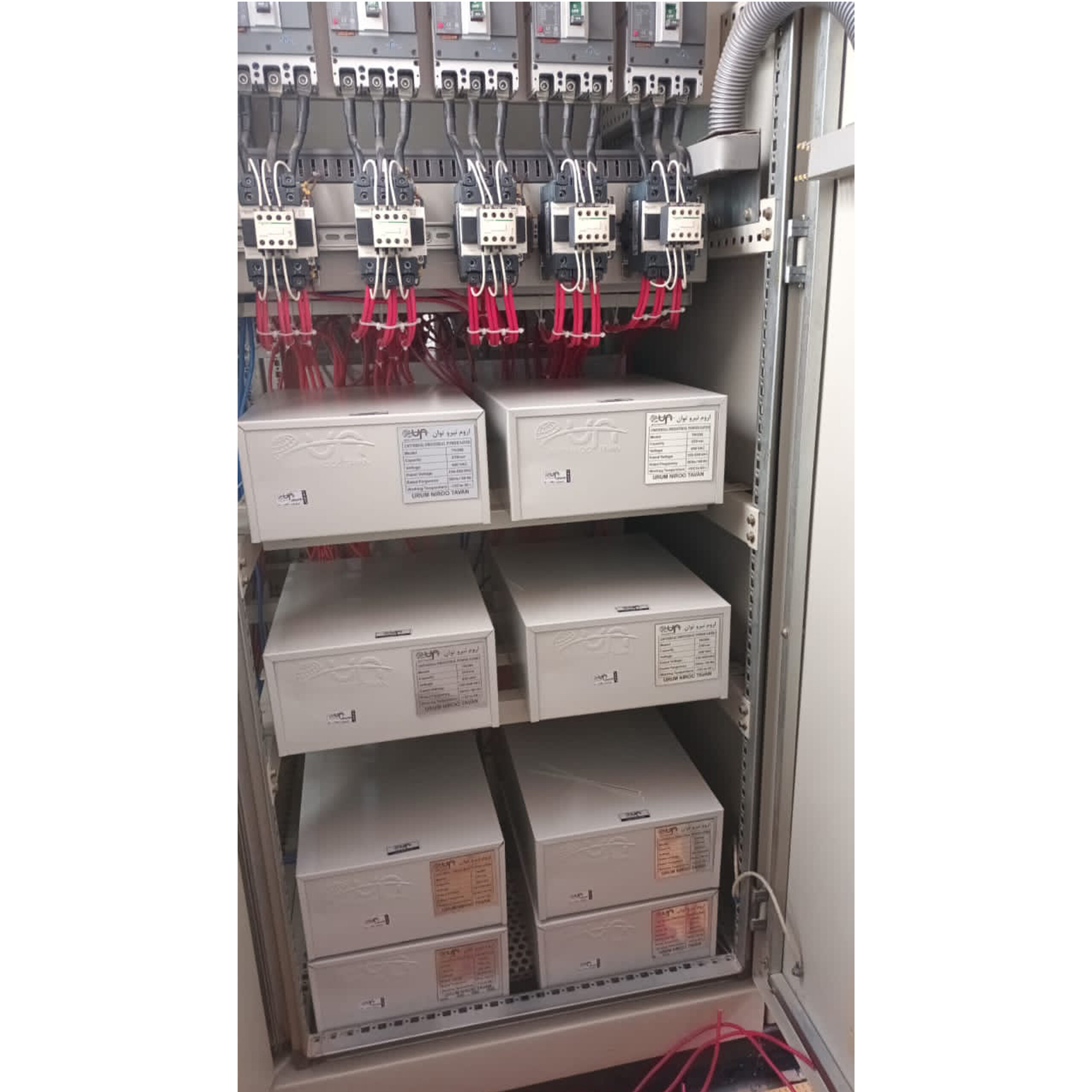Abstract: Capacitor banks usually need a lot of maintenance; capacitors are very dangerous because of their dangerous reaction when there is a fault or problem and the possibility of bursting and being damaged and even the possibility of fire. Observance of safety points according to valid standards should be on the agenda during the installation, repair and maintenance of capacitors. In order to protect the operators and the planning equipment, it is necessary to comply with the relevant instructions and electrical safety standards
Introduction
Capacitor banks play a vital role in power factor correction. Many environmental factors affect the capacitors installed to correct the power factor, such as working voltage, humidity, harmonics, temperature and useful life, on the ability to correct the power factor. Capacitor banks are involved. If they are not maintained or tested in a certain period of time, they will not be able to perform at their best. With the passage of time, the performance of the capacitors will become weaker, the power factor of the set will decrease, and the result will be the imposition of crimes and damages, and they may even cause damage to the grid power system
Types of errors in capacitor banks
The main errors in capacitor banks are
Overload
Short circuit
Frame or body error
Short circuit in capacitor film
Overload
Overload occurs due to transient or permanent overcurrent on capacitors and the reason can be as follows
The high voltage of the power supply or the beginning of the power input line
Existence of harmonic currents due to the presence of non-linear loads
Excess transient currents caused by switching or charging and discharging of adjacent capacitors
– Excessive increase in ambient temperature and increase in internal losses of capacitors
Overloads can increase the internal temperature of capacitors and destroy the dielectric, thus reducing its useful life
short circuit
A short circuit in capacitors with triangle or star arrangement can establish an internal or external error between conductors, or between phases or phases with zero
Frame or body error
The frame fault is an internal fault between the components of the capacitor and the frame itself is created by the metal enclosure.
Similar to an internal short circuit, the appearance of gas in the impermeable gas chamber of the capacitor creates excess pressure that may lead to accidental opening and dielectric leakage
Short circuit in capacitor film
A short circuit in the film of a component of the capacitor due to the internal connection creates an increase in the temperature of the junction and the result of the destruction of the capacitor film
Capacitor bank faults in power systems
- Evacuation and grounding
After leaving each of the capacitors of the capacitor bank from the circuit (power supply), some voltage remains inside it. At this moment, if the same capacitor enters the circuit again, it will increase the transient currents caused by switching, for this purpose, special resistors are used for the electric discharge of the capacitor, so it is necessary to wait until the capacitor resistors completely discharge and discharge it. slow These resistors are used to discharge the voltage in the capacitors to less than 50 volts in 5 minutes
However, the body of the capacitor bank must be earthed with a proper connection to the ground. In transmission and sub-distribution substations, a permanent switch is usually considered to ground the capacitors.
Even after the capacitors are fully grounded and discharged, it is recommended that individual capacitor units be short-circuited and grounded before handling the capacitors to ensure that there is no stored energy in the capacitors.
Inflated capacitors
Another disadvantage of capacitor units is their inflation. Capacitors that are severely inflated indicate that due to high heat and production of gases, high internal pressure has been created, which is the reason for possible sparks. These capacitors must be removed from the circuit
Frame or body error
The frame fault is an internal fault between the components of the capacitor and the frame itself is created by the metal enclosure.
Similar to an internal short circuit, the appearance of gas in the impermeable gas chamber of the capacitor creates excess pressure that may lead to accidental opening and dielectric leakage.
Short circuit in capacitor film
A short circuit in the film of a component of the capacitor due to the internal connection creates an increase in the temperature of the junction and the result of the destruction of the capacitor film.
Capacitor bank faults in power systems
Evacuation and grounding
After leaving each of the capacitors of the capacitor bank from the circuit (power supply), some voltage remains inside it. At this moment, if the same capacitor enters the circuit again, it will increase the transient currents caused by switching, for this purpose, special resistors are used for the electric discharge of the capacitor, so it is necessary to wait until the capacitor resistors completely discharge and discharge it. slow These resistors are used to discharge the voltage in the capacitors to less than 50 volts in 5 minutes.
However, the body of the capacitor bank must be earthed with a proper connection to the ground. In transmission and sub-distribution substations, a permanent switch is usually considered to ground the capacitors.
Even after the capacitors are fully grounded and discharged, it is recommended that individual capacitor units be short-circuited and grounded before handling the capacitors to ensure that there is no stored energy in the capacitors.
Inflated capacitors
Another disadvantage of capacitor units is their inflation. Capacitors that are severely inflated indicate that due to high heat and production of gases, high internal pressure has been created, which is the reason for possible sparks. These capacitors must be removed from the circuit.
Oil leakage from oil capacitors
Another defect in the capacitor bank is oil or gas leakage, which is caused by a failure or defect in the capacitor housing.
Recharging capacitor banks
When entering and putting the capacitor back into service, all the ground connections that were installed to discharge the capacitor must be disconnected, and between the discharge of the capacitor bank and the charging of the capacitor bank, there should be enough time to discharge the energy stored in the capacitor.
Initial visits before starting the capacitor bank
Correct and appropriate installation of the capacitor bank or capacitors from a mechanical point of view and observing the proper distance of the capacitors based on the standard and appropriate appearance conditions of all capacitors.
Check the capacity of capacitors and capacitor stages and match with the regulator or the relevant relays
In order to prevent any kind of arcing and failure of the relevant equipment, all the electrical connections of the terminals, fuses and contactors should be checked again so that they have the proper contact surface and proper conditions.
The connections related to the grounding of panels and capacitors should be reviewed again.
Testing the performance of all controllers, load switches, breakers and grounding switches.
Secondary visits after the capacitor bank are set up
After setting up the capacitor bank, you should first check the voltage increase in the terminals and compare it with the calculated values.
The imbalance of capacitor capacity should not cause a voltage difference of more than 110% in each unit.
All connections should be checked so that there is no arcing in them
Periodic visits
Periodic visits should include visits to all capacitor bank equipment:
The capacitor bank regulator should not have a fault, and in case of any fault or damage, the fault should be eliminated
If any of the fuses burn, the contactor and the corresponding capacitor will be removed from the circuit. During periodic visits, burnt fuses must be removed from the circuit and replaced
Visiting the contacts in order to ensure the correctness and health of their operation and the absence of damage and burning of the contactors and related connections
Visiting the appearance of the capacitors and the absence of oil leakage or the capacitors blowing up and bursting
All cable and wire connections must be healthy and not hot
Air conditioning valves and fans are healthy
The capacitor, which is colder than the other capacitors, is burnt and disconnected from the grid
The capacitor gets hot at the end of its life, so if the capacitors get too hot, the corresponding capacitor is defective and should be removed from the circuit
The capacity of the capacitor bank should be measured and if the capacitor capacity decreases by 25%, it should be replaced. Or if the capacitor
becomes two-phase, the defective capacitor must be removed from the circuit
Periodic repairs
Before any inspection and repairs on the capacitor banks, after cutting off the input power of the capacitors, wait until the capacitors are completely drained and discharged, and after the capacitors are fully discharged, manually discharge the capacitors in compliance with safety conditions
By periodically measuring the current, it is possible to ensure the health of the capacitors
If there is a difference in the current of the phases, the condition of the fuses and the capacitor should be re-tested
In order to check the health of the fuses, the voltage across each fuse should be less than 0.1 volts
In harmonic networks, the amount of current increase should not exceed 30% of the nominal currentImportant points in the installation and operation of capacitor banks
For the installation of capacitor banks, it is necessary to comply with the regulations of VDE0100, VDE0105 and the general recommendations of the Ministry of Energy.
According to VDE 0560 – Section 41, capacitor units must be suitable for a continuous current of at least 1.3 times the rated current. (Current calculated for nominal voltage with sinusoidal waveform and nominal frequency),
Considering 1.1 voltage and current fluctuations and even network harmonics, the maximum allowed current is considered 1.38
Keywords
Capacitor bank panel, periodic service of micro capacitors, energy optimization. Reactive power compensation. micro capacitor Power factor correction



